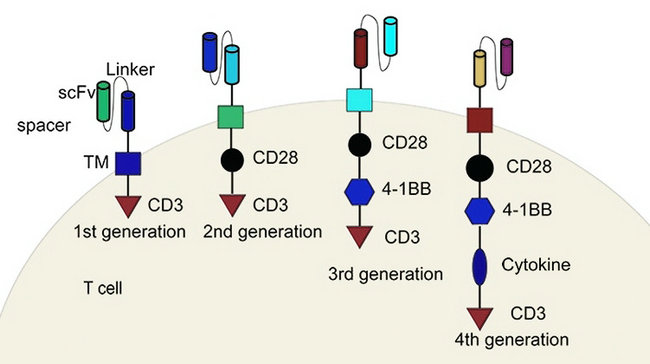| Quick Inquiry |
|
CAR (Chimeric Antigen Receptor) Expression Plasmids
RGBiotech is offering a list of CAR plasmids to assist your CAR T cell research. Our plasmids cover multiple CARs in the form of 2nd, or 3rd, or 4th generation. We also provide custom construction services to meet specific requirements. Please contact us at admin@rgbiotech.com for more information regarding our CAR plasmid products and services.
Product List for CAR Expression Plasmids
What is a chimeric antigen receptor (CAR)?
A chimeric antigen receptor (CAR), also named as a chimeric T cell receptor or an artificial T cell receptor or a chimeric immunoreceptor, is a transmembrane protein that is engineered to be expressed on surface of T cells and endows T cell to target a specific antigen existing on the surface of cancer cells.
CAR Structure
CAR is composed of five regions which are N-terminal signal / leader peptide, extracellular antigen recognition domain, extracellular hinge / spacer, transmembrane domain and intracellular T-cell signaling domain.
The function of the leader peptide (e.g. derived from CD8A or GM-CSF) is to direct the nascent protein into the endoplasmic reticulum.
The antigen recognition domain is typically the single-chain variable fragment (scFv) of a monoclonal antibody, structured as VH-(4GS)3-VL or VL-(4GS)3-VH.
Hinge sequence is usually derived from CD8A, IgG and CD28, which links the scFv to the transmembrane domain.
The transmembrane domain anchors the receptor to the T cell membrane and connects the ectodomain to the endodomain. Commonly used transmembrane domains include sequences from CD8A, CD28, CD4 and CD3.
Intracellular costimulatory domains, including CD28, ICOS, 4-1BB (TNFRSF9), OX40 (TNFRSF4), CD3ζ (CD247), CD27, are fused internally to the transmembrane domain and can transmit signaling inside the T cell.
CAR Evolution
According to the number of costimulatory domains, CARs can be grouped into first generation (CD3z only), second generation (one costimulatory domain + CD3z), or third generation CAR (more than one costimulatory domain + CD3z).

First generation CARs only use CD3ζ as the intracellular signaling domain.
Second generation CARs incorporate a co‐stimulatory domain, such as CD28 or 4‐1BB, to improve T cell proliferation, cytokine secretion, resistance to apoptosis, and in vivo persistence.
Third generation CARs add an additional co‐stimulatory domain, for example, CD28-41BB or CD28-OX40, to enhance T cell activities. Several studies have shown third-generation CARs exhibiting better effector functions compared to second‐generation CARs.
In addition, fourth generation CARs (also known as TRUCKs or armored CARs) have been generated that incorporate a third stimulatory signal including cytokines, such as IL-2, IL-5, IL-12 and co‐stimulatory ligands. These factors can enhance T cell expansion, persistence, and anti‐tumoral activities to promote therapeutic success.
|



